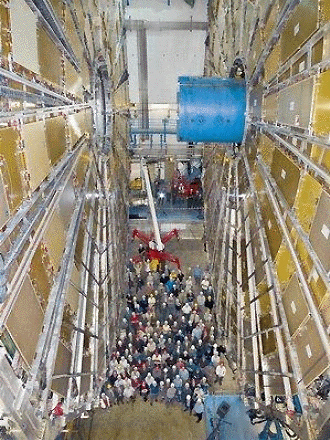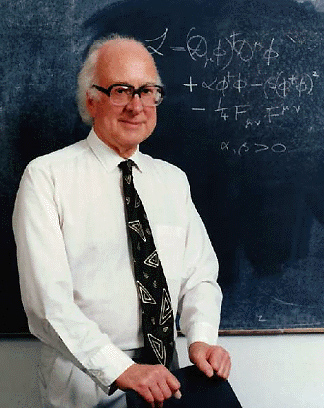Can the 'God Particle' Help Us Develop the 'Theory of Everything'?
BY: SUSHAN DAS & PURUSHOTTAMA JAGANNATHA DAS

Large Hadron Collider at CERN
Aug 14, CANADA (SUN) — In the Satsanga discussion (MP3) of July 11, 2008, is presented a scientific discussion about a sub-atomic particle which is popularly known as ‘God Particle’.
In 1964, particle physicist Peter Higgs discovered a sub-atomic particle which is now known as the Higgs boson. Scientists believe that the Higgs boson gives all matter it’s mass, and thus it is considered a fundamental particle. More recently, the Higgs boson has been known by a more colorful name as the ‘God Particle’. It is very interesting how the Higgs boson got this new name. The scientific community thinks that it is very surprising for this Higgs boson to get the name ‘God particle.’
The fact is that Nobel-prize winner Leon Lederman coined the theistic name for the Higgs boson as ‘God particle’. Higgs, whose name is associated with this fundamental particle, commented that, “I find it embarrassing because, though I’m not a believer myself, I think it is the kind of misuse of terminology which I think might offend some people.” [1] Higgs further says that, it wasn’t even Lederman’s choice, “He wanted to refer to it as that ‘goddamn particle’ and his editor wouldn’t let him.” [1] Beacause of its heavy mass, the particle is very difficult to detect and it is very expensive to build a large enough collider to prove its existence.

Peter Higgs
In May of 2008 Science Daily published a news item with the title “Large Hadron Collider Enables Hunt For ‘God Particle’ To Complete ‘Theory Of Everything’”. [2] The scientists built a Large Hadron Collider, which they believe will help them understand the interactions of the fundamental forces of nature. They also hope this will enable them to resolve the puzzle of why gravity is the weakest fundamental force.
It is mentioned in the Science Daily news article that, “The collider is a successor of sorts to the Superconducting Supercollider; a high-energy collider that was to have been built in Texas. The supercollider was first proposed in 1983 and construction began in 1991, but escalating cost estimates and other factors created controversy and Congress cancelled the project in 1993 after about $2 billion had been spent.”
In the mid 1990’s, scientists from the University of Washington (UW) started working on various aspects of the Large Hadron Collider. It is expected by UW scientists that “the collider will send hydrogen protons racing at nearly the speed of light in opposite directions through parallel underground cylinders that form a large circle about 16.5 miles in circumference, straddling the Swiss-French border. The cylinders intersect at various points, allowing proton collisions that produce sub-atomic particles that can be observed by one of the six detectors, each positioned at one of the intersections.” The tubes which are needed for the functioning of detectors have a skin just 1/64th of an inch thick. The major achievement that UW scientists achieved is that they were able to design and manufacture these tubes which require great precision.
His Holiness Bhakti Madhava Puri Swami, Ph.D., of the Bhaktivedanta Institute, discussed this topic during the Weekly Online Science/Spirituality Satsanga on July 20, 2008. Maharaja explained that billions of dollars were spent for building the large underground collider, which requires a giant magnetic cylinder in order to get charged particles to move at a very high speed. When these particles collide they will fission and produce many sub-particles. For example, when two protons collide with each other at a very high speed and at high-energy impact, they split into smaller sub-atomic particles which are also known as quarks. The combination of strongly interacting sub-atomic particles is called a hadron, in which the sub-atomic particles are called quarks. Quarks are smaller than neutrons and protons which are made up of quarks.
Electrons are not made up of any sub particles as they are already very small. There is a limit to the size of fundamental particles, thus we can not find further sub-atomic particles smaller than that. According to modern quantum theory we have to stop at a certain point beyond which we can no longer find any further sub-atomic particles. Electrons are extremely small particles and very light in weight. The classical radius of a
free electron is taken to be about 3×10-15 meters (weight 9.11 × 10-31
kg), and the classical radius of a free proton is taken to be about 1×10-15
(weight 1.67 × 10-27 kg).
The electron may be treated as a particle or as a wave according to the theory of quantum mechanics. Actually, the electron is merely a vector in Hilbert space. This space is not a physical space of three dimensions, but a mathematical space of infinite dimensions. Functional space does not have a space-time coordinate frame. Electrons are considered in that space to be a particular vector. Thus it is not proper to describe an electron as a particle. It is more appropriate to call it a vector, having certain dimensions in Hilbert space. That is all that can be said from a quantum mechanical point of view. From the point of view of classical physics, we talk about particles and waves, but from a quantum mechanical formulation, we only talk about vectors.
Because of the Heisenberg uncertainty principle we can only locate a particle within a certain limit of space. If we try to shrink the space and define the position of a particle very minutely, then we will expand the momentum unlimitedly. Momentum has to do with how fast a particle is moving. How fast a particle is moving has to do with how much energy a particle has. By decreasing the location of a particle to a very, very small space, we will increase the momentum unlimitedly.
As we mentioned, electrons occupy a very small space and have a very small mass. If we were to attempt to find a sub-atomic particle of an electron, it would have to be smaller than the electron. As a result, a sub part of an electron would have a momentum and mass beyond the one we had already determined for the electron itself, which would be impossible. Thus, it is to be noted that sub-atomic particles are found in fundamental particles like neutrons and protons, but not in electrons.
The collider is meant to allow the protons to collide, which would lead to the production of the sub-atomic particles. Scientists currently have the methods to measure the sub-atomic particles once they come out of the proton collision. But there is one special particle scientists are having difficulty in finding because it is very heavy in weight. It is known as the Higgs boson or the ‘God particle’.
HH Bhakti Madhava Puri Swami further explained the limitations of this new claim by scientists. The field of the Higgs boson can be compared to the old concept of the ether. Hence, what had already been dismissed by Einstein’s experiments regarding the existence of the ether is now being re-introduced by Higgs in the form of the Higgs boson field, since every particle is associated with its own field. The field of the Higgs boson is very important, because, according to Higgs, all the particles of the standard model of physics will get their mass from the Higgs boson when they enter its field. Some particles pick up a lot of mass (like quarks), some pick up very little mass, (like electrons) and some don’t even touch the field, and thus don’t pick up any mass, (like photons). Thus the field of the Higgs boson can be used to describe the mass of various types of elementary particles. It is due to this ability of Higgs’ theory to explain the mass of the fundamental particles and also refine the current Big Bang theory of the origin of the universe that the Higgs boson is referred to as the ‘God particle’.
However, there are many serious problems with this new theory. The biggest problem is that theories of particles are inherently defective because they can’t explain continuous phenomena. Particles, or quanta, refer to discontinuous phenomena. So how can we expect that this theory can be used to describe continuous phenomena like gravity? Gravity, as defined in the theory of general relativity, is not quantized. Acceleration is not defined as a quantized phenomenon. Although gravitons have been proposed for special relativity, mathematcal problems arise when applied to general relativity which deals with accelerated systems or gravity.
The standard model of physics includes three of the four fundamental forces: electromagnetic force, weak force, and strong force. It doesn’t explain the fourth fundamental force, gravity. The standard model applies to electro-magnetic theory, quantum mechanics, quantum electro-dynamics theory, and special relativity theory, but it cannot accommodate the general relativity theory, which includes gravity. Gravity refers to a force of acceleration, while special relativity deals with systems that are moving with constant velocity. Hence the Higgs boson or the ‘God particle’ may not be a proper means for developing the ‘Theory of Everything’ since it cannot accommodate the general relativity theory.
There are numerous and serious challenges which are attached to this new project which has been undertaken by the scientists. They dismiss environmental concerns, or public fears that a black hole may be created, etc. They are spending millions of dollars in their attempt to find ever more exotic particles. The exact figures spent on this project have not been provided to the general public. The money currently being used is coming from the government, which ultimately comes from taxes, while there are many other problems existing on our planet that need funding such as cleaning up environmental pollution, eliminating poverty, disease, starvation, etc.
When the advancement of knowledge becomes dependent upon big money science, it ultimately disempowers individuals own self-determination that is essential to their freedom as spiritual beings. Vedantic science of the theistic Bhagavat school of philosophy cultivates the development of that freedom and liberation from the entanglement of conditioned existence. A moment of such realization is far more valuable for achieving satisfaction and fulfillment in life than the endless pursuit of conditional material knowledge. The teachings of Sri Chaitanya Mahaprabhu provide the chance to cultivate this type of alternative science.
References:
Hear this Transcendental Nectar of Satsanga
You can browse year/month wise Streaming Satsanga MP3s here.
Timing of weekly Satsanga: 6:00 PM India time, Every Sunday.
You may visit our website to know the details about joining process for the online “Weekly Satsangas”.
All Glories all Sadhus, Guru and Vaisnavas.
Thanking you.
Your humble servants
Purushottama Jagannatha das & Sushen das
